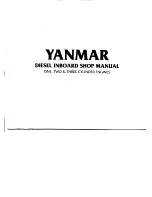
ProduCT dEsCrIPTIon
11
The electrical performance data on the rating plate is only valid if the motor is connected to a liquid
cooling system. The requirements of the liquid cooling system are shown on a separate rating plate
located on the motor, see Figure 1. An example of a separate rating plate can be seen in Figure 3.
Figure 3.
Example of separate rating plate with liquid cooling system data
2.2. Expected lifetime
The expected lifetime is very dependent on the motor´s winding and bearing temperature. The lower the
temperature the longer expected lifetime. The insulation system for the motor is class H, which means
that the winding temperature should not exceed 180°C. If the winding temperature is kept below this
limit, the expected lifetime of the insulation system is at least 20,000 hours. The electrical performance
data on the rating plate, see Figure 2, is the continuous operation point (S1). Operating in this point will
not compromise the expected lifetime. As a simplified method, the S1 power in a duty cycle can be
calculated by the root mean square method:
Motors for heavy electrical vehicles, type AMXE132
Product description
3BSY600011-BCM
12 (34)
The electrical performance data on the rating plate is only valid if the motor is connected to a
cooling system. The requirements of the cooling system are shown on a separate rating plate
located on the motor, see Figure 1. An example of a separate rating plate can be seen in Figure 3
Figure 3
Example of separate rating plate with cooling system data
2.2
Expected lifetime
The expected lifetime is very dependent on the motor´s winding temperature. The lower the
temperature the longer expected lifetime. The insulation system for the motor is class H, which
means that the winding temperature should not exceed 180°C. If the winding temperature is kept
below this limit, the expected lifetime of the insulation system is at least 25,000 hours. The
electrical performance data on the rating plate, see Figure 2, is the continuous operation point (S1).
Operating in this point will not compromise the expected lifetime. As a simplified method, the S1
power in a duty cycle can be calculated by the root mean square method:
𝑃𝑃𝑃𝑃
𝑒𝑒𝑒𝑒𝑒𝑒𝑒𝑒𝑒𝑒𝑒𝑒
=
�
1
𝑇𝑇𝑇𝑇 �
�𝑀𝑀𝑀𝑀
𝑖𝑖𝑖𝑖
∗
(
2
∗ 𝜋𝜋𝜋𝜋 ∗ 𝑛𝑛𝑛𝑛
60
)
𝑖𝑖𝑖𝑖
�
2
𝑇𝑇𝑇𝑇
𝑖𝑖𝑖𝑖=1
𝑛𝑛𝑛𝑛
=
𝑠𝑠𝑠𝑠𝑠𝑠𝑠𝑠𝑠𝑠𝑠𝑠𝑠𝑠𝑠𝑠𝑠𝑠𝑠𝑠
[
𝑟𝑟𝑟𝑟𝑠𝑠𝑠𝑠𝑟𝑟𝑟𝑟
]
𝑀𝑀𝑀𝑀
=
𝑡𝑡𝑡𝑡𝑡𝑡𝑡𝑡𝑟𝑟𝑟𝑟𝑡𝑡𝑡𝑡𝑡𝑡𝑡𝑡𝑠𝑠𝑠𝑠
[
𝑁𝑁𝑁𝑁𝑟𝑟𝑟𝑟
]
𝑇𝑇𝑇𝑇
=
𝑡𝑡𝑡𝑡𝑡𝑡𝑡𝑡𝑡𝑡𝑡𝑡𝑡𝑡𝑡𝑡𝑡𝑡𝑡𝑡
𝑐𝑐𝑐𝑐𝑐𝑐𝑐𝑐𝑐𝑐𝑐𝑐𝑡𝑡𝑡𝑡𝑠𝑠𝑠𝑠
𝑡𝑡𝑡𝑡𝑡𝑡𝑡𝑡𝑟𝑟𝑟𝑟𝑠𝑠𝑠𝑠
So, in a duty cycle, the rated torque and power on the rating plate could exceed the short term
(peak torque and peak power) as long as the winding temperature do not exceed 180°C.
As mentioned in the Product description, the motor is equipped with temperature sensors in the
stator winding. In most inverters, it is possible to set a warning limit and a shutdown limit for the
winding temperature. To not compromise the expected lifetime, the values in Table 2 are
recommended.
Action
Limit
Warning
170°C
Shut down
180°C
Table 2
Recommended temperature limits
The expected lifetime for bearings and external seals is not solely temperature dependent and
needs to be evaluated based on the duty cycle. Please contact your local ABB sales office for
technical support.
n = speed [rpm]
M = torque [Nm]
T = total cycle time
So, in a duty cycle, the rated torque and power on the rating plate could be exceeded short term (peak
torque and peak power) as long as the winding temperature do not exceed 180°C.
As mentioned in the Product description, the motor is equipped with temperature sensors in the stator
winding. In most inverters, it is possible to set a warning limit and a shutdown limit for the winding
temperature. To not compromise the expected lifetime, the values in Table 2 are recommended.
Action
Limit
Warning
180°C
Shut down
200°C
Table 2.
Recommended temperature limits.
NOTE: The warning and shut down limits are only valid for short term operation. Prolonged
operation at high stator winding temperatures will significantly impact the bearing grease
lifetime.
The expected lifetime for bearings and external seals is not solely temperature dependent and needs to
be evaluated based on the duty cycle. Please contact your local ABB sales office for technical support.












































